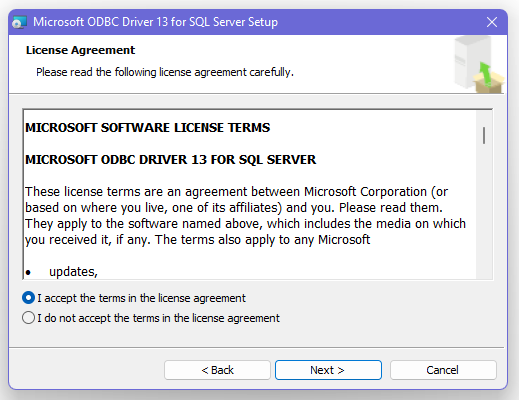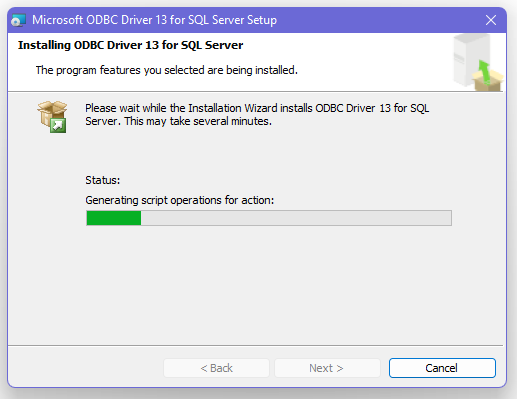

- #Microsoft® odbc driver 11 for sql server macos install#
- #Microsoft® odbc driver 11 for sql server macos series#
- #Microsoft® odbc driver 11 for sql server macos download#
- #Microsoft® odbc driver 11 for sql server macos windows#

Note that testodbc2 uses an account in the AWS US West (Oregon) region. Testodbc2 uses the account locator xy12345 as the account identifier. Testodbc1 uses an account identifier that uses anĪccount identifier that specifies the account myaccount in the organization The following example illustrates an odbc.ini file that configures two data sources that use different forms of an For details about the parameters that can be set for each DSN, see ODBC Configuration and Connection Parameters. Parameters are specified in the form of =. Any connection parameters you add to the DSN do not need to be specified in the ODBC connect string.Īny additional parameters, such as default role, database, and warehouse. ĭirectory path and name of the driver file, in the form of Driver = /opt/snowflake/snowflakeodbc/lib/universal/libSnowflake.dylib.Ĭonnection parameters, such as server and uid (user login name). If you are creating the first DSNįor the driver, you must manually create the odbc.ini file and add the entry to the file.ĭSN name and driver name (Snowflake), in the form of =. If a user or system DSN has already been created for the driver, add the new entry to the odbc.ini file that already exists in the corresponding directory for the type of DSN you are creating. The third restarts the Apache web server.Creating a DSN by Adding an Entry in the odbc.ini File ¶ Next, we execute three commands from the shell. Now edit /etc/odbc.ini and add a section like this (change to your database server IP): ĭescription=My Sample ODBC Database Connection Odbcinst -q -d -n "SQL Server Native Client 11.0"
#Microsoft® odbc driver 11 for sql server macos install#
install.sh install -lib-dir=/usr/local/lib64 -accept-license
#Microsoft® odbc driver 11 for sql server macos series#
Run the following series of commands, wget C99FC5535680/RedHat6/msodbcsql-.0.tar.gzĪnd press enter, and then cd msodbcsql-.0Īnd press enter, and then. configure -prefix=/usr -libdir=/usr/lib64 -sysconfdir=/etc -enable-gui=no -enable-drivers=no -enable-iconv -with-iconv-char-enc=UTF8 -with-iconv-ucode-enc=UTF16LEĪt a command prompt (logged in as root), type the following command make cd unixODBC-2.3.0/Īt a command prompt, type the following command: CPPFLAGS="-DSIZEOF_LONG_INT=8"Īt a command prompt, type the following command: export CPPFLAGSĪt a command prompt, type the following command.

On your Linux computer, execute the following command: cd ~/Downloads/Ĭhange to the unixODBC-2.3.0 directory.
#Microsoft® odbc driver 11 for sql server macos download#
To install new packages, run following command line (The installing user must have write privileges to the /opt directory by default.) yum install php httpd php-odbc php-pear.noarch php-pecl-apc php-xml php-xmlrpc php-tidy php-intl php-imap php-pecl-memcache glibc libuuid1 krb5 openssl gcc unixodbcĪdd these two lines to /etc/httpd/conf/nf SetEnv ODBCSYSINI /etcĬlick the Download link (unixODBC-2.3.0), on the left side of the page.Ĭlick the Download link, on the next page, and save the file in '~/Download' folder yum remove php httpd php-odbc php-pear.noarch php-pecl-apc php-xml php-xmlrpc php-tidy php-intl php-imap php-pecl-memcache glibc libuuid1 krb5 openssl gcc unixodbc Run the following command line to remove previous installations. In addition, the server must also have TCP/IP connections enabled with a static port defined (I will be using the default of 1433), and the firewall on the host for the SQL Server must allow connections to SQL Server on the static port. This requires a restart of the SQL Server service if changed.
#Microsoft® odbc driver 11 for sql server macos windows#
Below are steps to install, configure and start using the Microsoft SQL Server ODBC Driver for Linux, and using it from PHP - it assumes that you have SQL Server already available and configured to accept connections over TCP/IP, also that you have some familiarity with Linux.įirst, the SQL Server (and the appropriate database) must be configured for Windows and SQL Server Authentication.


 0 kommentar(er)
0 kommentar(er)
